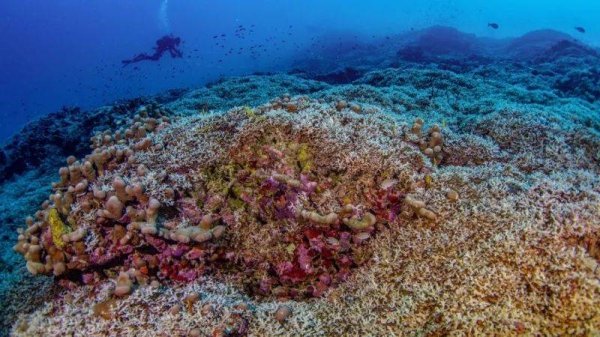In a discovery that has stunned scientists, the largest coral ever recorded has been found by researchers in the southwest Pacific Ocean. This mega coral, which is a collection of many tiny creatures forming one organism, could be over 300 years old, surpassing the size of a blue whale. The incredible find was made by a videographer working on a National Geographic ship exploring remote parts of the Pacific to understand the impact of climate change. Found in the Solomon Islands, the coral measures 34m wide, 32m long, and 5.5m high, making it a truly remarkable underwater spectacle.
The discovery of this giant coral comes at a crucial time as coral reefs globally are facing severe pressures due to rising ocean temperatures driven by climate change. Described as the “architects” of the seas, corals play a vital role in supporting marine life and livelihoods for millions of people worldwide. Coral reefs also support tourism and fishing industries, making their preservation critical for the economy. The Solomon Islands climate minister emphasized the importance of protecting this special place, as small island nations are particularly vulnerable to the effects of global warming.
Small island nations like the Solomon Islands heavily rely on marine resources for economic survival, making the protection of coral reefs crucial. Climate change has already caused destructive impacts in these regions, such as more powerful cyclones and coastal erosion. To address these challenges, developing countries are calling for increased financial support from wealthier nations to implement effective climate change strategies. By investing in sustainable industries and reducing activities that harm coral reefs, these nations can protect marine ecosystems for future generations.
Despite the challenges faced by coral reefs worldwide, the discovery of the largest coral specimen offers a glimmer of hope for scientists and conservationists. The healthy state of the Pavona clavus coral in the Solomon Islands provides a sanctuary for a variety of marine creatures, highlighting the importance of preserving these ecosystems. As global efforts to combat climate change intensify, studying this ancient coral can offer valuable insights into past oceanic conditions, helping researchers better understand how corals have thrived in the face of environmental challenges.
The unveiling of the largest coral specimen coincided with the UN climate talks COP29 in Baku, Azerbaijan, showcasing the urgent need for action to address climate change and protect the world’s precious marine ecosystems. As awareness grows about the fragile state of coral reefs and the threats they face, initiatives to safeguard these vital habitats are gaining momentum. By raising awareness about the significance of coral reefs and the need for conservation efforts, nations can work together to ensure the long-term health and sustainability of these underwater wonders for generations to come.











